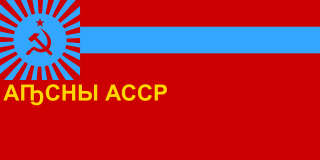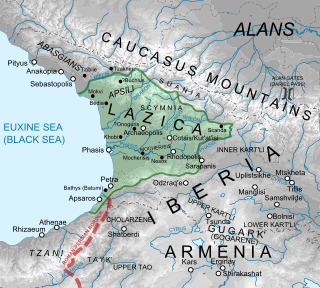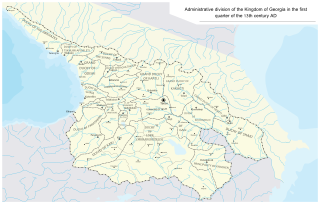 W
WThis article refers to the history of Abkhazia from its pre-historic settlement by the lower-paleolithic hunter-gathers during the mesolithic and neolithic periods to the post-1992-1993 war situation.
 W
WThe Abasgoi or Abasgians were one of the ancient tribes inhabiting western region of Abkhazia, who originally inhabited lands north of Apsilae, corresponding to today's Ochamchira District. In 550, during the Lazic War, the Abasgians revolted against the Eastern Roman (Byzantine) Empire and called upon Sasanian assistance. General Bessas however suppressed the Abasgian revolt.
 W
WThe Abkhaz Autonomous Soviet Socialist Republic, abbreviated as Abkhaz ASSR, was an autonomous republic of the Soviet Union within the Georgian SSR. It came into existence in February 1931, when the Socialist Soviet Republic of Abkhazia, originally created in March 1921, was transformed to the status of Autonomous Soviet Socialist Republic within the Georgian SSR.
 W
WAbkhazians of African descent or Afro-Abkhazians, also known as African Caucasians, were a small group of people of African descent in Abkhazia, who used to live mainly in the settlement Adzyubzha at the mouth of the Kodori River and the surrounding villages on the eastern coast of the Black Sea.
 W
WThe Bedia Chalice is a piece of the medieval Georgian goldsmithery, a liturgical vessel made of ducat gold and richly decorated. Dated to c. 999, the chalice was commissioned by King Bagrat III for the Bedia Monastery in Abkhazia. Only the bowl of the vessel is preserved and currently kept at the Georgian National Museum in Tbilisi.
 W
WThe Bichvinta Four Gospels is a 12th-century illuminated manuscript of the Four Gospels in Georgian, copied in the nuskhuri script. It is named after the cathedral church in Abkhazia, where the book was discovered in 1830. The manuscript is now at the Georgian National Center of Manuscripts, Tbilisi, as H-2120.
 W
WThe Bichvinta mosaic is a 5th or 6th-century floor mosaic from the ruined early Christian church at a cape in the coastal town of Bichvinta or Pitsunda, anciently known as Pityus, in Abkhazia/Georgia. It depicts symbolic animals, birds, and plants.
 W
WThe Circassian genocide was the Russian Empire's systematic mass murder, ethnic cleansing, forced migration, and expulsion of 800,000–1,500,000 Circassians from their homeland Circassia, which roughly encompassed the major part of the North Caucasus and the northeast shore of the Black Sea. It has been recorded that during the events, the Russian and Cossack forces used various brutal methods to entertain themselves, such as tearing the bellies of pregnant women and removing the baby inside, then feeding the babies to dogs. Russian generals such as Grigory Zass described the Circassians as "subhuman filth", and justified their killing and use in scientific experiments. This occurred in the aftermath of the Russo-Circassian War in the second half of the 19th century. The displaced people were settled primarily to the Ottoman Empire.
 W
WThe national emblem of the Abkhaz Autonomous Soviet Socialist Republic was adopted in 1937 by the government of the Abkhaz Autonomous Soviet Socialist Republic. The emblem is identical to the emblem of the Georgian Soviet Socialist Republic.
 W
WThe dolmens of Abkhazia are found in several locations in Abkhazia/Georgia. A dolmen is a type of pre-historic single-chamber megalithic tomb. These structures are located in the north of Abkhazia, best studied being those at Eshera. Similar structures are found in the neighboring territory of Northwestern Caucasus.
 W
WThe coat of arms of the SSR Abkhazia was adopted by in 1925 when the SSR Abkhazia ratified its constitution. The coat of arms was used until 1931, when SSR Abkhazia was transformed into the Abkhaz Autonomous Soviet Socialist Republic.
 W
WThe Abkhaz–Georgian conflict involves ethnic conflict between Georgians and the Abkhaz people in Abkhazia, a de facto independent, partially recognized republic. In a broader sense, one can view the Georgian–Abkhaz conflict as part of a geopolitical conflict in the Caucasus region, intensified at the end of the 20th century with the dissolution of the Soviet Union in 1991.
 W
WThe Mokvi Four Gospels is a 13th-century illuminated manuscript of the Four Gospels in Georgian, copied in the nuskhuri script and richly adorned with miniatures at the Mokvi Cathedral in Abkhazia. The Mokvi Gospels contains 329 pages, each 30 x 23.5 cm in size, and a long cycle of 157 miniatures painted on gold. The manuscript is preserved at the Georgian National Center of Manuscripts in Tbilisi.
 W
WOpsites is the name twice mentioned by the 6th-century East Roman (Byzantine) historian Procopius in his De Bellis, while recounting the events related to the Lazic War (541–562) fought between the Eastern Roman and Sassanid Persian empires over the Caucasian state of Lazica.
 W
WThe Duchy of Tskhumi was a duchy (saeristavo) in a mediaeval Georgia. Ruled by a House of Shervashidze, the duchy existed from 8th to 14th century, in the north-western part of Georgia and comprised territories around modern Sukhumi, Abkhazia.
 W
WThe Principality of Abkhazia emerged as a separate feudal entity in the 15th-16th centuries, amid the civil wars in the Kingdom of Georgia that concluded with the dissolution of the unified Georgian monarchy. The principality retained a degree of autonomy under the Ottoman, and then the Russian rule, but was eventually absorbed into the Russian Empire in 1864.
 W
WThe Sasanian or Sassanid Empire, officially known as the Empire of Iranians, and called the Neo-Persian Empire by historians, was the last Persian imperial dynasty before the Muslim conquest in the mid seventh century AD. Named after the House of Sasan, it endured for over four centuries, from 224 to 651 AD, making it the longest-lived Persian dynasty. The Sasanian Empire succeeded the Parthian Empire, and reestablished the Iranians as a superpower in late antiquity, alongside its neighbouring arch-rival, the Roman-Byzantine Empire.
 W
WSochi conflict was a three-party border conflict which involved the counterrevolutionary White Russian forces, Bolshevik Red Army and the Democratic Republic of Georgia, each of which sought control over the Black Sea town of Sochi. The conflict was fought as a part of the Russian Civil War and lasted with varying success from July 1918 to May 1919, and ended through British mediation establishing the current official border between Russia and Georgia.
 W
WThe Socialist Soviet Republic of Abkhazia was a short-lived republic within the Caucasus region of the Soviet Union that covered the territory of Abkhazia, and existed from 31 March 1921 to 19 February 1931. Formed in the aftermath of the Red Army invasion of Georgia in 1921, it was independent until 16 December 1921, when it agreed to a treaty uniting it with the Georgian Soviet Socialist Republic. The SSR Abkhazia was largely similar to an autonomous Soviet republic, though it retained nominal independence from Georgia, being given certain features only full union republics had, like its own military units. Through its status as a "treaty republic" with Georgia, Abkhazia joined the Transcaucasian Soviet Federative Socialist Republic, which united Armenian, Azerbaijani, and Georgian SSRs into one federal unit, when the latter was formed in 1922. The SSR Abkhazia was abolished in 1931 and replaced with the Abkhaz Autonomous Soviet Socialist Republic within the Georgian SSR.
 W
WTsebelda fortress is a Late Antique/Early Medieval fortification near the village of Tsebelda, in the eponymous valley, in Abkhazia, Georgia.
 W
WThe Tsebelda iconostasis is an Early Medieval peace of Christian art from Abkhazia/Georgia, a limestone fragment of an altar screen from the 7th or 8th century, which were discovered near the village of Tsebelda in the 1880s.
 W
WAbkhazian women, particularly those of older age, are traditionally portrayed as peacemakers, decision makers, and mediators in times of combat and conflict. The women in Abkhazia only have a marginal in number within the showground of Abkhazian politics. At present, the Abkhazian females are more active as participants in the realm of business and in activities related to establishing organizations for women in their country.